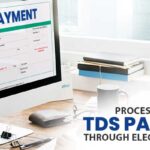Introduction
The purpose behind introducing the concept of Tax deducted at source (TDS) is to collect tax from the source of income. Here, the person liable to make the payment to any other person shall deduct TDS. The person liable to make the payment is known as the “Deductor” and the person to whom the payment is made is known as the “Deductee”. It is the liability of the Deductor to remit the TDS into the account of the central Government.
Generally, the person (Deductee) receiving the payment is liable to pay taxes. Through the concept of TDS, Government ensures to collect the taxes in advance on the specified nature of income. The deductee/recipient takes credit for the amount already deducted and paid on his behalf.
Who is liable to deduct TDS?
The person making the specified payment (i.e. Professional fees, Rent, Interest, commission, etc) under the income tax Act is required to deduct TDS at the time of processing such payment.
In case the person making the payment is an individual or HUF, whose books are not required to be audited, is not required to deduct TDS. However, in case of rent payments made by individuals and HUF exceeding Rs 50,000 per month, are required to deduct TDS @ 5% even if the individual or HUF is not liable for a tax audit. Such individuals or HUF need not apply for a Tax Deduction Account number (TAN).
Rates to deduct TDS
TDS rates are specified under the relevant provisions of the Income Tax Act. For the TDS rate chart, click here.
What is the due date to deposit TDS to the government?
Usually, TDS must be deposited by the 7th day of the subsequent month. For example, TDS deducted in the m/o September must be remitted/deposited by 7th October. However, TDS deducted in the month of March can be deposited by 30th April.
How to Deposit TDS?
TDS has been deposited using challan ITNS 281. TDS can be deposited through Electronic mode and Physical Mode. Read our article for step by step guide to depositing TDS through electronic mode.
Below is the process for offline TDS deposit:
- Fill challan ITNS 281
- Draw the cheque for an amount equivalent to TDS
- Submit the challan along with a cheque to the Authorised bank branch
- The authorized bank will deposit the TDS and generate the challan
When to file the TDS return?
Filing of TDS return is mandatory to pass on the TDS credit to the deductee. It is mandatory for the deductor to file the TDS return. The TDS return is to be submitted quarterly. Refer below table for the due dates :
|
Quarter |
Period |
Last date of filing |
|
1st Quarter |
April – June |
31st July |
|
2nd Quarter |
July – September |
31st October |
|
3rd Quarter |
October – December |
31st January |
|
4th Quarter |
January – March |
31st May |
What are the different types of TDS Forms?
TDS forms are depending on the nature of payment .Refer below table for various TDS forms:
|
Particulars |
Form |
Periodicity of TDS return |
|
TDS on salaries to residents |
Form 24Q |
Quarterly |
|
TDS on all payments other than salaries to residents |
Form 26Q |
Quarterly |
|
TDS on interest, dividend or any other payment to Non-residents |
Form 27Q |
Quarterly |
|
TDS on sale of property |
Form 26QB |
Monthly* |
|
TDS on Rent U/s 194-IB |
Form 26QC |
Monthly* |
* 30 days from the end of the month in which TDS is deducted
What is TDS certificate?
There are 4 types of TDS certificate such as Form 16, Form 16A, Form 16B and Form 16C. The deductor of TDS is liable to issue the TDS certificate to the deductee. Basis such TDS certificate, deductee can claim the TDS credit while filing their income tax return.
|
Form |
Particulars |
Frequency |
Due date |
|
Form 16 |
TDS on Salary payment |
Yearly |
31st May |
|
Form 16A |
TDS on all payments other than salaries to residents |
Quarterly |
15 days from due date of filing return |
|
Form 16B |
TDS on sale of property |
Every transaction |
|
|
Form 16C |
TDS on Rent U/s 194-IB |
Every transaction |



